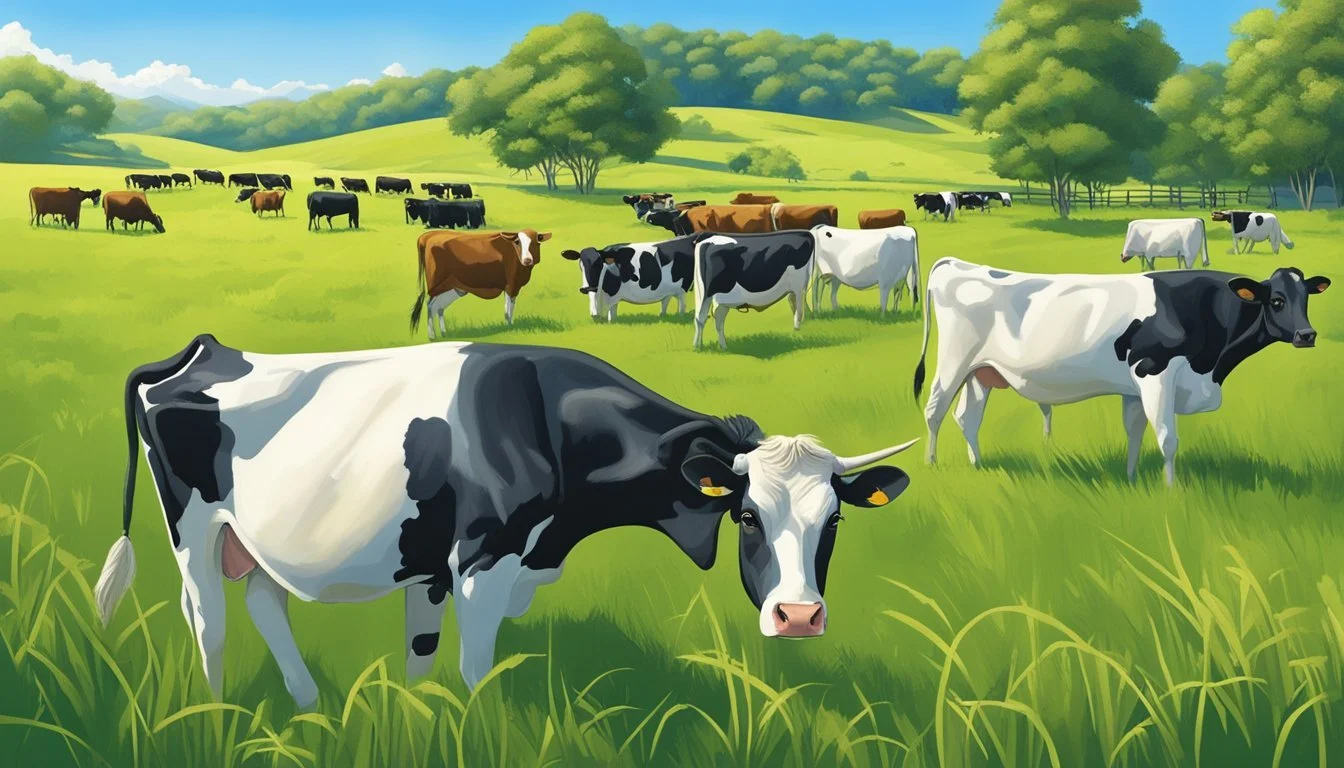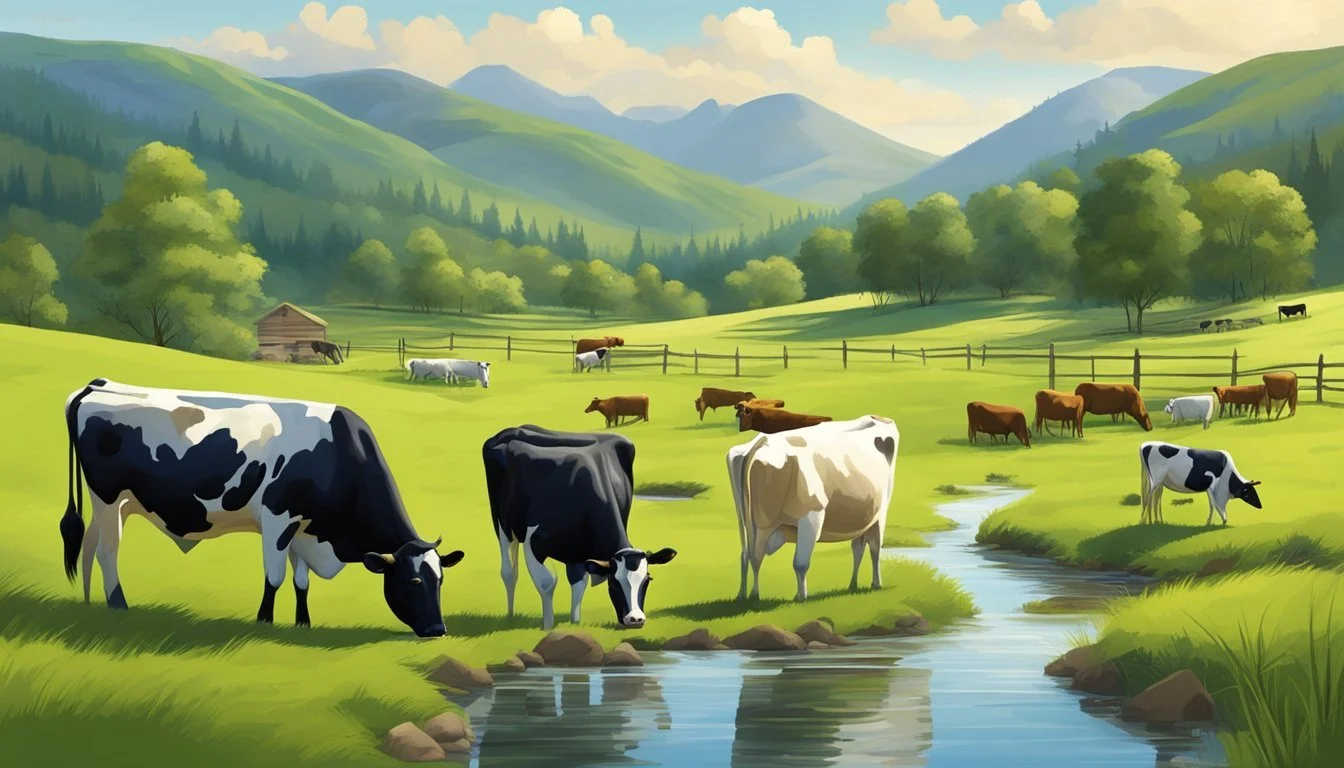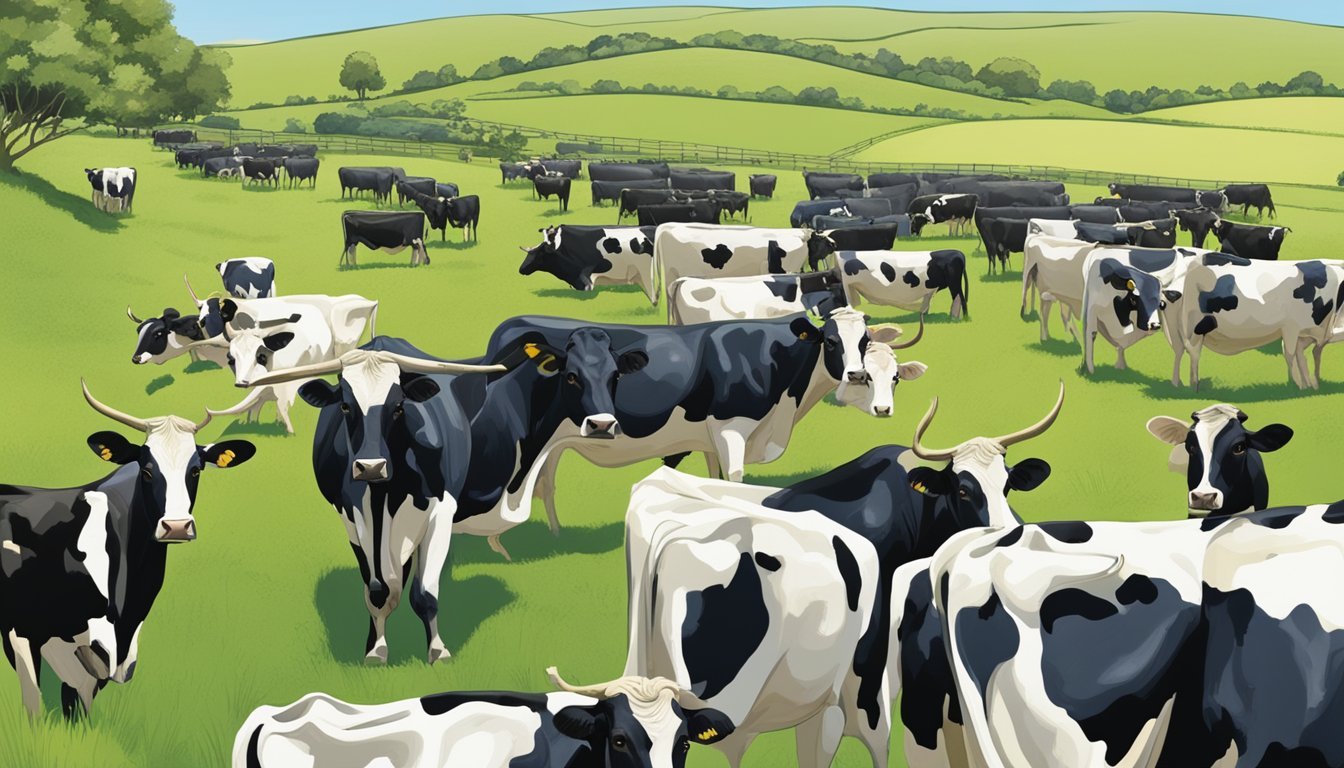What Are the Nutritional Requirements for Dairy Cattle?
Key Components for Optimal Health
Understanding the nutritional requirements for dairy cattle is essential for optimum health, growth, and milk production. Proper nutrition is not only crucial for producing high-quality milk but also for ensuring the overall well-being and longevity of dairy cows. Dairy cattle dietary needs vary depending on the stage of life, from calves to heifers and into their lactation periods. Calves require a diet rich in colostrum initially, followed by milk replacers and then solid feeds, to support their rapid growth and developing immune systems.
As heifers transition to becoming milk-producing cows, their nutrition must support not just growth but also the demands of lactation. The lactating dairy cow's diet is a carefully balanced mix of proteins, energy, vitamins, and minerals to meet their increased nutritional needs. Energy and protein are vital for maintaining milk production levels, while minerals like calcium and phosphorus play a role in milk composition and bone structure.
Nutritional strategies must be adjusted continuously to match the different life stages and production cycles. For example, during the dry period, dairy cows have different nutritional needs which are less focused on milk production but more on preparing for the next lactation and ensuring healthy calving. Both the quantity and quality of the feed, as well as precise nutrient management, are key to supporting good health and productive longevity in dairy cattle. For more detailed guidance, farmers often refer to resources like the MSD Veterinary Manual or the latest research on the subject.
Fundamentals of Dairy Cattle Nutrition
Dairy cattle require a balanced diet to maintain their health and enhance milk production. This composition of their feed must be closely managed to meet their specific dietary needs for a range of nutrients, with particular attention to the balance of proteins, carbohydrates, fats, water, minerals, and vitamins during different stages of their life and lactation cycle.
Nutrient Requirements of Dairy Cattle
Dairy cattle have high nutritional requirements, which can be quite challenging to meet, especially during lactation. Lactating dairy cows require a diet rich in energy, primarily in the form of carbohydrates and fats, to support milk production, as well as to maintain their own body condition. A significant amount of protein is also necessary to support the synthesis of milk proteins. The requirements for proteins, carbohydrates, and fats depend on factors such as breed, the stage of lactation, and overall health.
A comprehensive source of details on the nutrient needs can be referred to in the Nutrient Requirements of Dairy Cattle: Eighth Revised Edition, which includes the most recent research on the subject. Proper hydration is equally important with water serving as a vital nutrient that plays a crucial role in temperature regulation, digestion, and milk production. It is essential for dairy farmers to provide ample clean water to support these physiological functions.
Essential Nutrients for Dairy Cattle
Dairy cattle need an array of minerals and vitamins in their diet for optimal health and productivity. Minerals such as calcium and phosphorus are critical for bone development, milk production, and the regulation of the body's pH levels. Other important minerals include potassium, sodium, magnesium, and trace elements like copper, zinc, and selenium. Dairy cattle diets often include vitamin A and vitamin D supplementation; the former is required for various body functions including vision and immune health, while the latter helps in calcium absorption and regulation.
To achieve the necessary balance of nutrients, dairy cattle feed typically consists of a mix of forages, grains, protein supplements, and specialized mineral and vitamin premixes. Adequate nutrition not only supports the animal’s health and reproductive efficiency but also impacts the quality and quantity of the milk produced. Given the complexity of dairy nutrition, it is recommended that diets be formulated with the help of a dairy nutritionist to ensure that all dietary needs are met and that the feed is both safe and cost-effective for producers.
Life Stage Nutritional Needs
Proper nutrition is critical for dairy cattle at each stage of their life cycle. It supports optimal growth, health, and productivity, and varies noticeably between calves, heifers, lactating cows, dry cows, and transition cows.
Calf Nutrition
At the onset of life, a calf's nutritional foundation is built on colostrum, the first form of milk produced immediately following delivery. Calves require colostrum within the first few hours post-birth, as it is rich in antibodies essential for disease resistance. Colostrum intake should be followed by milk or milk replacer diets high in protein and energy to support rapid early growth.
Heifer Nutrition
As calves transition to heifers, the focus shifts to diets that promote steady growth without becoming overweight. Nutrition at this stage includes a balance of concentrates and forages to prepare them for their future as lactating dairy cows. Achieving an optimal growth trajectory is necessary to ensure heifers are ready for breeding at an appropriate age and weight.
Nutrition During Lactation
Lactating dairy cows have increased nutritional needs to support milk production. Energy is the most critical nutrient during this stage, often supplied in the form of carbohydrates and fats. Protein, vitamins, and minerals must be carefully balanced to maintain milk yield, composition, and cow health. Feeding guidelines for large-breed dairy cattle emphasize high nutrient density to meet their substantial requirements.
Dry Cow Nutrition
Dry cows, those in a non-lactating period, require a diet that prepares them for the next lactation and parturition. Their nutritional regime is slightly reduced and adjusted to avoid metabolic disorders. The focus is on maintaining body condition with adequate fiber to stimulate rumination and prevent excessive weight gain.
Transition Cow Nutrition
The transition cow phase refers to the period shortly before and after calving. Nutrition during this time is pivotal to manage stress and prevent metabolic diseases. Diets are designed to support the shift back to lactation, with emphasis on energy balance, adequate mineral intakes, and the introduction of components the cow will encounter in the milking herd's diet.
Ration Formulation for Dairy Cattle
Effective ration formulation for dairy cattle ensures that cows receive the nutrition they need to maintain health, productivity, and profitability. It involves a careful balance of feedstuffs that meet the dietary energy, protein, fiber, and micronutrient requirements without compromising feed intake and digestibility.
Assessing Feedstuff Composition
Dairy nutritionists test the components of feedstuffs to determine their nutritional value and digestibility. This step is critical for accurate ration formulation as it informs the energy and protein content of ingredients while considering factors like starch, fatty acids, and neutral detergent fiber (NDF).
Dietary Energy Sources
Energy is usually the most limiting nutrient in dairy cattle diets. Dietary energy sources should support optimal milk production and health. Cows metabolize energy from carbohydrates, such as starches and sugars, and volatile fatty acids produced by the digestion of fiber in the rumen.
Protein and Amino Acid Balancing
Meeting metabolizable protein requirements is essential for milk synthesis and cow health. Amino acid balancing is necessary for optimizing protein use. Ration formulators strive to combine feedstuffs that match the cow's requirements for essential amino acids, leading to improved milk yield and quality.
Fiber and Forage Inclusion
Fiber is a staple in a dairy cow's diet, chiefly provided through forage. It is essential for proper rumen function and health. The inclusion of adequate fiber, specifically NDF, helps regulate intake and ensures rumen health while preventing issues like acidosis.
Mineral and Vitamin Supplementation
Minerals and vitamins are vital for various physiological functions. Dairy rations incorporate supplements to cover any gaps left by natural feedstuffs. For instance, calcium and phosphorus are important for bone health and metabolic processes, and vitamin D is crucial for calcium absorption.
Feeding Management and Strategies
Effective feeding management and strategies are central to meeting the nutritional needs of dairy cattle. Precision in monitoring intake and managing feed systems is critical to maximizing both cow health and milk production efficiency.
Monitoring Dry Matter Intake
Monitoring dry matter intake (DMI) is vital to ensure dairy cattle receive the right amount of nutrients to meet their energy demands, particularly during lactation. Accurate feeding management involves calculating DMI regularly to adjust rations accordingly, taking care to avoid both underfeeding and overfeeding.
Total Mixed Ration (TMR) Approach
The Total Mixed Ration (TMR) method involves combining forages, grains, supplements, and other feed ingredients into one homogenous mixture, providing consistent nutrition in every bite. This approach supports optimal rumen function and helps prevent sorting behaviors which can lead to nutritional imbalances.
Pasture-Based Feeding Systems
In pasture-based feeding systems, cattle graze on forage crops, which must be carefully managed to sustain nutrient-rich pastures. Rotational grazing strategies optimize pasture regrowth and maintain sward structure, contributing to efficient use of available forage.
Feed Efficiency and Refusal Management
Maximizing feed efficiency is about achieving the greatest milk production per unit of feed consumed. Closely related is the management of feed refusal—excess feed that cattle have not consumed—which needs to be consistently measured to adjust future feed allotments and minimize waste.
Special Considerations in Dairy Nutrition
Dairy cattle have precise nutritional needs that are critical to their health, milk production, and reproduction. Special considerations in dairy nutrition encompass not just what is fed, but also the environment in which cattle are reared and the quality of resources, like water, that they consume.
Water Availability and Quality
Access to clean water is paramount in dairy nutrition. Dairy cows require abundant, fresh water to remain hydrated and to maximize milk yield. The water intake of a cow can vary significantly, often doubling during lactation and periods of heat stress. High water quality, free from contaminants and within an accessible range, ensures that dairy cattle can meet their hydration needs without compromising their health or production.
Heat Stress and Nutrient Utilization
Heat stress in dairy cattle can lead to reduced feed intake, altered nutrient utilization, and lowered milk production. Implementing heat abatement strategies such as providing shade, ventilation, and cooling systems can mitigate these effects. During hot weather, cows may require dietary adjustments to account for decreased feed intake and increased energy expended on cooling.
Feed Additives and Functional Ingredients
The inclusion of feed additives can enhance dairy cattle nutrition by improving feed efficiency, health, and milk component profiles. Functional ingredients like enzymes, probiotics, and yeasts can support rumen function and overall digestive health. These additives are carefully selected based on their ability to fulfill specific nutritional gaps or health concerns within the herd.
Nutrition and Dairy Production Outcomes
Proper nutrition is pivotal in achieving optimal dairy production outcomes. It directly impacts milk yield, milk components, and overall cattle health, affecting both productivity and profitability.
Milk Yield and Components Analysis
Dairy cattle require a balanced diet to maximize milk yield and maintain the desired milk fat concentration. Nutrients play a specific role in milk production; for example, energy-rich feeds can increase total milk volume, while the appropriate balance of fatty acids is crucial for maintaining optimal milk fat levels. Consistency in nutrient supply is key to preventing fluctuations in milk composition.
Body Condition and Ruminant Health
A dairy cow's body condition score serves as an indicator of nutritional status and is intrinsically linked to rumen health. Maintaining a balanced diet helps to ensure a functional rumen, which in turn aids digestion and absorption of nutrients. Proper nutrition is also associated with reduced instances of udder edema and milk fever, conditions that can directly affect the health and productivity of the cow.
Reproduction and Longevity
Nutrition exerts a significant influence on reproductive performance and longevity in dairy cattle. Adequate nutrient intake supports the demands of lactation and aids recovery post-calving, preparing the cow for subsequent pregnancies. Nutritional management aimed at optimizing body condition can improve reproductive efficiency and extend the productive lifespan of the dairy cow.
Impact of Nutrition on Dairy Farming Sustainability
Proper nutrition in dairy cattle is critical not just for the health and productivity of the animals but also plays a significant role in the sustainability of dairy farming. It influences the dairy industry’s environmental footprint, including greenhouse gas emissions and nutrient losses.
Environmental Impacts of Feeding Practices
Feeding practices in the dairy industry directly affect the environmental impact of milk production. The National Research Council provides guidelines for nutrient requirements which, when followed, can minimize the ecological footprint of dairy cattle by enhancing feed efficiency. Efficient feeding reduces the amount of feed needed for productive functions, thereby reducing greenhouse gas production linked to feed cultivation, processing, and transportation.
Innovative feeding strategies that optimize the nutritional intake of dairy cattle can lead to a lower volume of waste produced. As a result, there is less nutrient loss in manure, which can contribute to soil degradation and water pollution. Furthermore, precision feeding practices help in producing manure that is more uniform and thus more manageable in terms of environmental impact.
Reduction of Nutrient Losses and Emissions
The dairy industry continuously seeks methods to reduce nutrient losses and emissions to enhance sustainability. One aspect of this is improving the management of manure, as it is a prominent source of methane, a potent greenhouse gas. By optimizing cattle diets based on guidelines from authorities like the National Research Council, the dairy industry can improve nitrogen and phosphorus utilization in cows. This optimization leads to lower concentrations of these elements in manure, reducing nutrient losses in manure and, consequently, the emissions.
Implementing diets that precisely meet the cows' needs helps to ensure that fewer excess nutrients are excreted and potentially lost to the environment. Effective manure management strategies can further mitigate this concern by appropriately recycling nutrients back into croplands. These practices, in concert, curtail emissions and bolster the environmental sustainability of dairy farming.
Technical and Practical Resources
Dairy cattle nutrition necessitates precision and a comprehensive understanding of the animals' dietary needs throughout different life stages. Access to reliable nutrient requirement tables and advice from specialized nutritionists play crucial roles in ensuring healthy and productive livestock.
Nutrient Requirement Tables and Tools
The National Research Council (NRC) provides extensive resources such as feeding guidelines and feed composition tables that are essential for determining the nutrient requirements of dairy cattle. These tables are supported by scientific research and often come with accompanying software tools to assist farmers and nutritionists in creating precise diets for their herds.
Role of Dairy Nutritionists
Dairy nutritionists are specialists who apply the knowledge from resources such as the NRC's publications to devise optimal feeding programs. They analyze feed composition data and correlate it with animal nutrient requirements to deliver balanced diets that promote health and productivity.
Implementing Best Practices on the Farm
Adopting best practices in dairy cattle nutrition involves not only consulting print media or text from authoritative sources but also incorporating technological advancements such as computer programs that simplify the management of feeding plans. Farms implement these practices through regular assessment of their cattle's health and milk output, using detailed nutrition plans to enhance both.
Emerging Trends and Innovations in Dairy Nutrition
The dairy nutrition landscape is swiftly transforming thanks to technological advancements and a deeper understanding of feed efficiency and cow health. Producers now have an array of innovative tools and models at their disposal, aimed at optimizing dairy production systems and improving the utilization of various feedstuffs, including the coproducts of biofuel production.
Advances in Feed Composition Analysis
Technological progress has significantly enhanced the accuracy of feed composition analysis. For example, near-infrared spectroscopy (NIR) is increasingly utilized for its rapid and non-destructive evaluation of feedstuff composition. This allows for more precise dietary formulations, ensuring that dairy cattle receive optimally balanced nutrients tailored to their specific needs.
Another innovation in this area is the exploration of coproducts of biofuel production, such as dried distillers grains with solubles (DDGS), as potential cost-effective and nutrient-rich alternatives to traditional feed components. These products are now more commonly included in dairy cattle diets, especially given their high protein content and energy value.
Future of Nutritional Models and Practices
In the future of nutritional models and practices, there is a significant shift toward a more individualized approach in dairy cattle nutrition. Sophisticated computer models are being developed to simulate and predict animal performance based on diet, which facilitates more informed decisions regarding feed management.
Moreover, the integration of dairy production systems with advanced digital tools like precision feeding software marks a revolutionary step in dairy management. These systems enable real-time monitoring and adjustment of diets to address the specific requirements of individual animals or groups, thereby improving efficiency and productivity while reducing waste and environmental impact.





